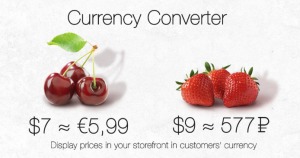International ecommerce, also known as cross-border ecommerce, presents huge opportunities for your business in terms of growth and increased revenue.
The practice of selling globally is obviously nothing new. Merchants have been moving goods and services across continents for centuries. What is new, however, is the level of connectedness that exists between companies and potential customers.
McKinsey & Company says, “Digital technologies enable even the smallest company or solo entrepreneur to be a ‘micromultinational,’ selling and sourcing products, services, and ideas across borders.”
Additionally, it’s estimated that international transactions could triple in scale by 2025 thanks to the Internet and other digital technologies.
So, as a marketer or business owner, what does this mean for you? How can you expand your business and start connecting with and converting an international audience? Learn more below.
Localize Your Content And Marketing
Connecting with international customers starts with speaking their language. You need to provide an option to translate your website into the languages spoken in the countries you’re targeting (you can use Google Translate to do this).
Additionally, you should minimize the amount of text appearing in graphics, as this text won’t be translated.

You need to go deeper than just translating your website, though. You also need to research and be mindful of cultural differences and cultural barriers that may exist. And while it may be costly, if you want to optimize your international ecommerce efforts, you should customize your offer and messaging so they’re tailored to each local market you serve.
And whenever you can, consult with people who represent your target audience to get their input.
Consulting with local marketing experts comes in handy when it comes to keywords as well. Simply translating keywords into different language doesn’t always suffice, as there are often cultural influences at play. So it’s best to confer with native experts.
Have A Plan For Shipping And Customs Duty
Shipping
First, you want to choose a shipping partner that’s reliable, well-established and has a good reputation handling international deliveries. Major players, like UPS, USPS, and FedEx, are all good choices.
Second, you need to think about how you want to set your shipping rates (or if you want to offer free shipping):
- Flat rate – You calculate your average shipping costs and then set either a flat rate or a flat percentage based on your customers’ order subtotals.
- Carrier-calculated rates – You let shipping partners, like UPS, USPS, and FedEx, calculate your shipping rates for you.
Customs Duty
With international ecommerce, you have to think about customs duty in addition to shipping. Normally, customers are responsible for paying any customs duty.
But, if you want to increase your conversion rate by simplifying your customers’ shopping experience, you can use a tool such as the duty and tax calculator by Zonos to calculate these costs for your customers at checkout so they don’t have to.

The calculator works with UPS, FedEx, and DHL and costs $99/month, plus a 1.9% transaction fee per completed international order.
Consider Different Payment Options
Accommodate local buyers’ preferences
Customers’ preferred payment options can vary from country to country. For example, residents of certain countries would rather use direct debit while citizens of other countries typically prefer doing online bank transfers.
So you need to research local buyers’ preferences and have your payment options accommodate those preferences.

Offer payment options in a number of currencies
Another component you need to consider is currency. Customers prefer making purchases with their local currency, or at least one they’re familiar with.
And so, you ideally want to work with a global payment provider that allows you to list your offers in a variety of currencies. Providers that let you do this include…
(You also want to make sure your payment provider has a solid reputation for security, especially when it comes to purchase protection.)
Use a currency converter app
If your payment provider doesn’t let you list different currencies, you can use an app like Ecwid’s currency converter, which converts the prices of ecommerce products into the currencies of 130 countries.

The currency converter costs $4.99/month, but you can start with a free trial.
What are your thoughts about selling globally? Is this something you’re currently doing or considering? Get in touch via social media and share your feedback.




